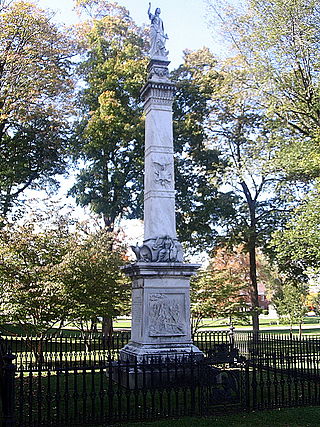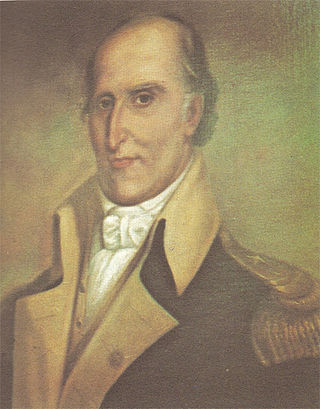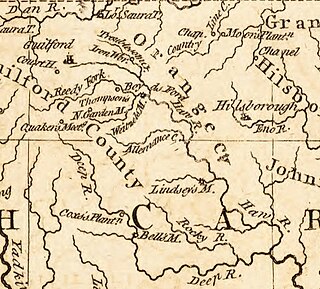
The Battle of Kings Mountain was a military engagement between Patriot and Loyalist militias in South Carolina during the Southern Campaign of the American Revolutionary War, resulting in a decisive victory for the Patriots. The battle took place on October 7, 1780, 9 miles (14 km) south of the present-day town of Kings Mountain, North Carolina. In what is now rural Cherokee County, South Carolina, the Patriot militia defeated the Loyalist militia commanded by British Major Patrick Ferguson of the 71st Foot. The battle has been described as "the war's largest all-American fight".

Patrick Ferguson was a Scottish officer in the British Army, an early advocate of light infantry and the designer of the Ferguson rifle. He is best known for his service in the 1780 military campaign of Charles Cornwallis during the American Revolutionary War in the Carolinas, in which he played a great effort in recruiting American Loyalists to serve in his militia against the Patriots.
Benjamin Cleveland was an American pioneer and officer in the North Carolina militia. He is best remembered for his service as a colonel in the Wilkes County Regiment of the North Carolina militia during the War of Independence, and in particular for his role in the American victory at the Battle of Kings Mountain.

The Battle of Minisink took place during the American Revolutionary War at Minisink Ford, New York, on July 22, 1779. It was the only major skirmish of the Revolutionary War fought in the upper Delaware River valley. The battle was a decisive Iroquois and Loyalist victory, as the Patriot militia was hastily assembled, ill-equipped and inexperienced.

Titus Cornelius, also known as Titus, Tye, and famously as Colonel Tye, was a slave of African descent in the Province of New Jersey who escaped from his master and fought as a Black Loyalist during the American Revolutionary War; he was known for his leadership and fighting skills. He fought with a volunteer corps of escaped Virginia Colony slaves in the Ethiopian Regiment, and he led the Black Brigade associators. Tye died from tetanus from a musket wound in the wrist following a short siege in September 1780 against Captain Joshua Huddy. He was one of the most feared and effective guerrilla leaders opposing the American patriot forces in central New Jersey.

The Battle of Kettle Creek was the first major victory for Patriots in the back country of Georgia during the American Revolutionary War that took place on February 14, 1779. It was fought in Wilkes County about eleven miles (18 km) from present-day Washington, Georgia. A militia force of Patriots decisively defeated and scattered a Loyalist militia force that was on its way to British-controlled Augusta.

The Battle of Johnstown was one of the last battles in the northern theatre of the American Revolutionary War, with approximately 1,400 engaged at Johnstown, New York on October 25, 1781. British regulars and militia, commanded by Major John Ross of the King's Royal Regiment of New York and Captain Walter Butler of Butler's Rangers, had raided the border area. Local American forces, led by Colonel Marinus Willett, blocked the British advance. As the British withdrew northwards Willett and his men marched to German Flatts to try to cut them off. The British managed to escape, but Walter Butler was killed.

The Battle of Charlotte was an American Revolutionary War battle fought in Charlotte, North Carolina on September 26, 1780. The battle took place at the Mecklenburg County Court House; which is now the site of the Bank of America tower at Trade and Tryon Streets in uptown Charlotte. An advance guard of General Charles Cornwallis' army rode into town and encountered a well-prepared Patriot militia under the command of William R. Davie in front of the court house. A skirmish ensued in which George Hanger, leading the British cavalry, was wounded. The small Patriot force, which had not intended more than token resistance, withdrew north toward Salisbury upon the arrival of Cornwallis and the main army.
The Battle of Colson's Mill was a battle of the American Revolutionary War that took place in North Carolina on July 21, 1780. A Patriot militia under William Lee Davidson scattered a gathering of Loyalists at Colson's Mill, near the junction of the Rocky and Pee Dee Rivers in present-day Stanly County, North Carolina.

The Battle of Kemp's Landing, also known as the Skirmish of Kempsville, was a skirmish in the American Revolutionary War that occurred on November 15, 1775. Militia companies from Princess Anne County in the Province of Virginia assembled at Kemp's Landing to counter British troops under the command of Virginia's last colonial governor, John Murray, Lord Dunmore, that had landed at nearby Great Bridge. Dunmore was investigating rumors of Patriot troop arrivals from North Carolina that turned out to be false; he instead moved against the Princess Anne militia, defeating their attempt at an ambush and routing them.

The Battle of Lindley's Mill took place in Orange County, North Carolina, on September 13, 1781, during the American Revolutionary War. The battle took its name from a mill that sat at the site of the battle on Cane Creek, which sat along a road connecting what was then the temporary state capital, Hillsborough, with Wilmington, North Carolina.

The Battle of Ramsour's Mill took place on June 20, 1780 in present-day Lincolnton, North Carolina, during the British campaign to gain control of the southern colonies in the American Revolutionary War. The number of fighters on each side of the battle is still an issue of contention, but Loyalist militiamen outnumbered Patriot militia and had captured a group of Patriots who they were planning to hang on the morning of June 20.
Huntsville is a small unincorporated community in Yadkin County, North Carolina, United States. The community was formerly chartered in 1792 by Charles Hunt of Salisbury, NC and was chartered again in 1822. It has a Huntsville Volunteer Fire Department, and Huntsville Community Center which is in front of a baseball/softball field which is home to Huntsville little league.

The Battle of Musgrove Mill, August 19, 1780, occurred near a ford of the Enoree River, near the present-day border between Spartanburg, Laurens and Union Counties in South Carolina. During the course of the battle, 200 Patriot militiamen defeated a combined force of approximately 300 Loyalist militiamen and 200 provincial regulars.
Barbecue is an unincorporated community located in the Barbecue Township of Harnett County, North Carolina, United States. It is a part of the Dunn Micropolitan Area, which is also a part of the greater Raleigh–Durham–Cary Combined Statistical Area (CSA) as defined by the United States Census Bureau.
Jane Thomas was the wife of John Thomas, a colonel in South Carolina who fought for the rebels in the American Revolution. She passed key intelligence that thwarted an ambush of Whig forces.
Huck's Defeat or the Battle of Williamson's Plantation was an engagement of the American Revolutionary War that occurred in present York County, South Carolina on July 12, 1780, and was one of the first battles of the southern campaign to be won by Patriot militia.
The Province of Georgia was a significant battleground in the American Revolution. Its population was at first divided about exactly how to respond to revolutionary activities and heightened tensions in other provinces. Georgia was the only colony not present in the First Continental Congress in 1774. When violence broke out in 1775, radical Patriots took control of the provincial government, and drove many Loyalists out of the province. Georgia subsequently took part to the Second Continental Congress with the other colonies. In 1776 and 1778, Georgia served as the staging ground for several important raids into British-controlled Florida. The British army captured Savannah in 1778, and the American and French forces failed to recapture the city during the Siege of Savannah in 1779. Georgia remained under British control until their evacuation from Savannah in 1782.
William "Bloody Bill" Cunningham (1756–1787) was an American loyalist infamous for perpetrating a series of bloody massacres in South Carolina's backcountry in the fall of 1781 as commander of a Tory militia regiment in the Revolutionary War. Though his family were loyal to the British crown, Cunningham initially enlisted in the Continental Army as part of the State of South Carolina's 3rd regiment in 1775. His tenure in the rebel army was an unhappy one and Cunningham changed sides to fight for the British in 1778. He earned the nickname "Bloody Bill" for the violent, ruthless nature of his raids on rebels and patriot civilians.

The Battle of Torrence's Tavern was a minor engagement of the American Revolutionary War that took place in what was the western portion of Rowan County, North Carolina, approximately 10 miles (16 km) east of the Catawba River near modern-day Mooresville in Iredell County. Torrence's Tavern was a part of the larger Southern campaign of the American Revolution, which, by 1780–1781 involved a series of clashes between the British Army and Loyalist militia and the Continental Army and Patriot militia in the Piedmont region of North and South Carolina.











